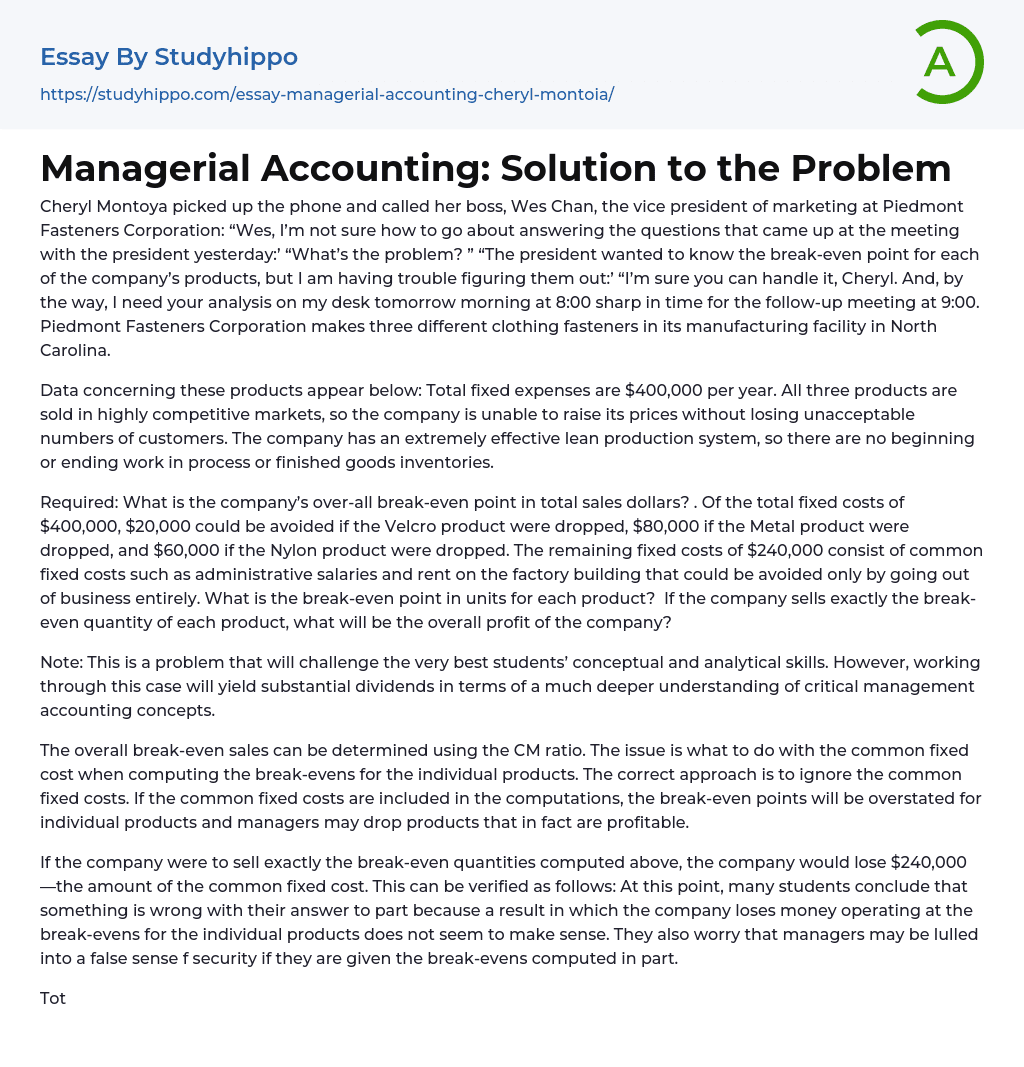

Managerial Accounting: Solution to the Problem Essay Example
Cheryl Montoya picked up the phone and called her boss, Wes Chan, the vice president of marketing at Piedmont Fasteners Corporation: “Wes, I’m not sure how to go about answering the questions that came up at the meeting with the president yesterday:’ “What’s the problem? ” “The president wanted to know the break-even point for each of the company’s products, but I am having trouble figuring them out:’ “I’m sure you can handle it, Cheryl. And, by the way, I need your analysis on my desk tomorrow morning at 8:00 sharp in time for the follow-up meeting at 9:00. Piedmont Fasteners Corporation makes three different clothing fasteners in its manufacturing facility in North Carolina.
Data concerning these products appear below: Total fixed expenses are $400,000 per year. All three products are sold in highly competitive markets, so
...the company is unable to raise its prices without losing unacceptable numbers of customers. The company has an extremely effective lean production system, so there are no beginning or ending work in process or finished goods inventories.
Required: What is the company’s over-all break-even point in total sales dollars? . Of the total fixed costs of $400,000, $20,000 could be avoided if the Velcro product were dropped, $80,000 if the Metal product were dropped, and $60,000 if the Nylon product were dropped. The remaining fixed costs of $240,000 consist of common fixed costs such as administrative salaries and rent on the factory building that could be avoided only by going out of business entirely. What is the break-even point in units for each product? If the company sells exactly the break-even quantity of each product, what will be the overal
profit of the company?
Note: This is a problem that will challenge the very best students’ conceptual and analytical skills. However, working through this case will yield substantial dividends in terms of a much deeper understanding of critical management accounting concepts.
The overall break-even sales can be determined using the CM ratio. The issue is what to do with the common fixed cost when computing the break-evens for the individual products. The correct approach is to ignore the common fixed costs. If the common fixed costs are included in the computations, the break-even points will be overstated for individual products and managers may drop products that in fact are profitable.
If the company were to sell exactly the break-even quantities computed above, the company would lose $240,000—the amount of the common fixed cost. This can be verified as follows: At this point, many students conclude that something is wrong with their answer to part because a result in which the company loses money operating at the break-evens for the individual products does not seem to make sense. They also worry that managers may be lulled into a false sense f security if they are given the break-evens computed in part.
Total sales at the individual product break-evens is only $317,500 whereas the total sales at the overall break-even computed in part is $732,000. Many students (and managers, for that matter) attempt to resolve this apparent paradox by allocating the common fixed costs among the products prior to computing the break-evens for individual products. Any of a number of allocation bases could be used for this purpose—sales, variable expenses, product-specific fixed expenses, contribution margins, etc. We usually take a tally
of how many students allocated the common fixed costs using each possible allocation base before proceeding. ) For example, the common fixed costs are allocated on the next page based on sales. Allocation of common fixed expenses on the basis of sales revenue:
Therefore, the total fixed expenses are $300,000 rather than $400,000. By dropping the two products, the company would go from making a profit of $40,000 to suffering a loss of $60,000.
The reason is that the two dropped products were contributing $100,000 toward covering common fixed expenses and toward profits. This can be verified by looking at a segmented income statement like the one that will be introduced in a later chapter.
- Accounts Receivable essays
- Auditor's Report essays
- Balance Sheet essays
- Costs essays
- Financial Audit essays
- International Financial Reporting Standards essays
- Tax essays
- Accountability essays
- Cash essays
- Principal essays
- Management Accounting essays
- Internal Control essays
- Accounting Software essays
- Cash Flow essays
- Chief Executive Officer essays
- Convenience Store essays
- Firm essays
- Training And Development essays
- Unilever essays
- Variable Cost essays
- Virgin Group essays
- Bargaining essays
- Entity essays
- Pest analysis essays
- Net Present Value essays
- Income Statement essays
- Accounting essays
- Andrew Carnegie essays
- Automation essays
- Business Cycle essays
- Business Intelligence essays
- Business Model essays
- Business Operations essays
- Business Software essays
- Cooperation essays
- Cooperative essays
- Corporate Social Responsibility essays
- Corporation essays
- Customer Relationship Management essays
- Family Business essays
- Franchising essays
- Harvard Business School essays
- Harvard university essays
- Human Resource Management essays
- Infrastructure essays
- Inventory essays
- Logistics essays
- Management essays
- Manufacturing essays
- Market essays



